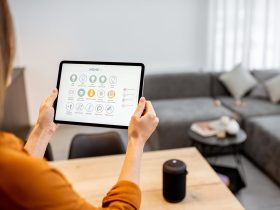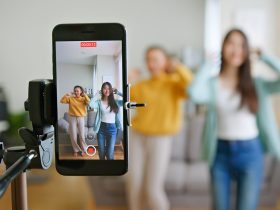Your phone is like a time capsule—a snapshot of your life—and is filled with precious photos, messages, and more. You’ll also have it set up just the way you like it. Now imagine if that were all to disappear because your device was lost, damaged, or stolen. Worst-case scenarios can happen. Make backing up your Android phone top of your to-do list today and follow this simple guide. Then show your mobile companion that you truly care: Avira Antivirus Security for Android helps protect it from online threats and clears out clutter.
Why is backing up your phone so important?
It’s almost insulting to call today’s smartphones “phones”. They’re pint-sized, high-performance computers, digital companions, memory archivers, and personal assistants all rolled into one. They’re also packed with everything you cherish and need, from beloved videos of your child’s first birthday to calendar appointments you don’t want to miss. We know they’re most definitely smart, but it’s easy to forget that they’re not invincible: If you don’t back up your Android, your device is a single point of failure and its precious cargo is vulnerable to loss, theft, accidental damage, hardware issues, and malware attacks. All it could take to wipe away your data is something as simple as a glass of water…or you could become a victim of sophisticated cybercrime like phone hacking, whereby unauthorised people gain access to your device.
There are also happier circumstances when you’ll be grateful you backed your data up. You may want to quickly transition to a new device or free up storage space on your existing one (without deleting any memories). They say that all good things come in threes and it’s no different with backup: Be extra cautious and follow the 3-2-1 rule of backup, which means keeping two local backups in different locations and one in cloud storage. Like all good habits, you need to keep doing it to be effective. Ideally, you should back up your phone at least once a week, but daily is even better. Speaking of best practice, remember to show your phone regular TLC and clear it of digital clutter. When phones run out of storage space, they can run more slowly (and—shock, horror—you might not be able to save that video of your toddler’s first steps). Learn how to free up storage space on your Android now.
Thankfully, there are multiple ways to back up a smartphone both manually and automatically. We’ll take a deep dive into the options for Android below. If you’re an Apple user, don’t despair: Here are three easy ways to back up and restore your iPhone. Hopefully, you won’t ever become a hapless victim of lost data, and those embarrassing photos of your children are safe forever (or at least until you get to show them on their wedding day).
Backup methods for Android phones: Know your options
Backup is broadly divided into cloud-based and local solutions. Cloud-based services store data on remote servers offsite. They’re an ideal option if you have vast data volumes or want to access your backups from anywhere. Local solutions are stored on or near your desktop. Please note: A Google 7 Pixel Pro was used to illustrate the steps below. Instructions may vary depending on your phone’s make and model.
In-built cloud solutions
The cloud-based backups that are tied into your Android device are generally the easiest to use as you’ll be navigating a seamlessly integrated ecosystem: There’s Samsung Cloud for Galaxy phones, while Google Drive allows Android users with a Google account to automatically back up data to Google, including apps, app data, and call history.
Third-party cloud solutions
You’re spoilt for choice if you want to look at cloud services beyond those chosen by your phone’s manufacturer: If you subscribe to Microsoft Office 365, they throw in 1TB of free cloud storage in OneDrive (as per Microsoft cloud storage website, Nov. 2024). Other options with oodles of cost-effective space are Amazon Photos, Dropbox, and Mega.
Manufacturer-specific software
There are official Android backup apps that let you conveniently share the screen and data between your PC and mobile device. The three most common are Samsung SideSync, Huawei HiSuite, and Xiaomi PC Suite.
External storage
You can also back up an Android device to external storage, such as a USB flash drive, an SD card, or even an external hard drive. As they’re entirely separate, your data will usually still be safe here even if you’re phone isn’t (just don’t lose them!).
Computer backups
As the name suggests, your Android data will be stored on your personal computer. If you only have small amounts of data, then a desktop backup can be convenient. There are various options, such as via a USB or wirelessly.
And if you ever do delete files that you haven’t backed up, it’s not the end of the world—nor the end of those files. Thankfully, there are a few ways to recover deleted files on all major operating systems.
Backing up your Android phone with Google
As we mentioned, Google’s cloud service is conveniently built into Android phones and is generally considered the simplest backup option. Each Google account includes 15 GB of free storage, which is shared across Gmail, Google Drive, and Google Photos. To add to this storage quota, you’ll have to purchase a Google One membership. If you don’t want to pay for extra space, regularly clear your phone of space-gobbling digital junk and move the files you don’t need to your PC or another external backup option.
The Google One app lets you automatically back up the contents of your phone (such as photos, contacts, and messages) plus manage your Google cloud storage. You can download the Android version from the Google Play Store.
Follow these steps to back up automatically to Google Drive
- Open the Settings app on your phone and tap Google. The Google Services window opens. Listed at the top, you’ll see the storage available for the Google account you’re signed into.
- Select Manage backup.

- Make sure the toggle switch next to Backup by Google One is set to on. (If you’re using this option for the first time, follow the on-screen instructions to set it up). Then tap the Back up now button beneath it. Remember that backups can take several hours if you haven’t backed up before! Leave your phone plugged into a charger and connected to Wi-Fi overnight to be sure that a full backup will run.

Congratulations! You’ve now hopefully activated automatic backups to your Google Drive account. If you phone does fall into a puddle, your data should remain safe and dry in the cloud.
Get started with Google Photos
- If it’s not already preinstalled on your phone, download the free Google Photos app from the Google Play Store.
- Open Google Photos and log into your Google account. Give all the permissions required to back up your photos.
- Tap on your account profile picture in the top right-hand corner. In the window that opens, tap on Backup.

- Choose Turn on backup and Google Photos will begin to back up your photos. You can also set the image quality.

Using third-party cloud services to back up your Android
There’s a downside to straying off the well-trodden Google backup pathway. You’ll have to make a little more effort if you choose solutions that aren’t as tightly woven into your Android. If you want to automatically save photos and videos with OneDrive for Android, for example, here’s how:
- Install and open the OneDrive app.
- Within the app, tap the Me icon at the bottom.

- Tap Settings and then Camera backup.

- Select the account you want to back up.
- Switch on Include videos to back up videos automatically. You can also select other backups.

Backing up your Android with manufacturer-specific software
You can also back up the contents of your Android using official Android backup apps. Here are three popular options:
Samsung Flow (SideSync tool)
Samsung Flow lets you connect devices and share content between them. If you want to share screens, windows, and data specifically between a Samsung Android device and a PC or Mac, then its SideSync feature is what you’re looking for.
Huawei HiSuite
Designed for Huawei phones and tablets running Android 4.0 or later, HiSuite offers a variety of features, including data management, system recovery, application management, and more. You can also use the app to back up contacts, messages, emails, and other content from your Android device to a computer.
Xiaomi PC Suite
This app is compatible with various Xiaomi devices, including Redmi phones. Set it to regularly back up and restore photos, music, videos, contacts and other files that are stored in your Android phone. You can also share your PC’s internet connection and remotely manage files on your Android.
How to back up your Android to external storage
There are a few options if you’re determined to go this route although most people find cloud backup far simpler. Files By Google is your friend if you’re looking to move or copy files to an SD card and detailed information is available via Google Support. Samsung offers Smart Switch which lets you manage and back up your data to an SD Card (from the Smart Switch PC program) or USB storage.
How to back up your Android to a computer
Before you back up an Android phone to a PC, you’ll need to ensure that both devices are compatible with each other, or you risk losing data. Once you’ve successfully followed the steps below, you should sleep more easily knowing that your photos, videos, music and other files now exist on your PC as well as your smartphone. You’ve banished that single point of failure!
Do this essential preparation before backing up to a PC
Step 1: Your PC demands compatibility drivers for your Android, so you’ll need to install these first. Usually, it’s easiest to download a driver package from your smartphone vendor’s official website.
Step 2: Download a Google USB driver ZIP file and extract it into a folder on your PC.
Step 3: Connect your Android to the PC via a USB cable.
Step 4: Now it’s time to enable USB debugging. On Android 4.2.x to Android 10, follow these steps:
- Tap Menu to access the App drawer.
- Open Settings and scroll down and tap on About phone.
- In the window that opens, locate Build Number and tap it repeatedly until the notification “You are now a developer” appears.
- Return to the Settings pane and scroll down to System. Select Developer options and turn on USB debugging. Tap OK to confirm your selection.
You’re now ready to start the backup process on your PC.
Back up your Android to a PC with a USB cable
This is probably the most common way to transfer files from an Android device to a PC because you can use the same USB cable that’s needed to charge your phone.
- Plug your phone into the computer using a USB cable.
- On your Android phone, slide down the notification menu to find and tap on the Android System message: “Charging this device via USB”.
- In the USB preferences window that opens, choose File Transfer.

- Click on the notification on your PC to allow sync over mobile data and follow any instructions regarding permissions.
- On your phone, make sure that Device and app notifications are enabled under App settings.

Your phone will appear as a connected device on your PC. Simply copy and paste any files across that you’d like to have on both devices.
Back up your Android to a Mac using Macdroid
Android and Mac operating systems have never played nicely with each other. There used to be an official tool for Macs called Android File Transfer, but it’s been removed from Android.com. Thankfully, there are third-party solutions for connecting your Android phone to a Mac computer. Macroid, for example, promises to offer the “ultimate convenience of transferring any files between your Mac computer and Android devices connected via USB or wirelessly.” (Macdroid app website, status November 2024). If you’d like to give it a go, follow these steps.
- Connect your Android phone to your Mac computer using a USB cable.
- Download, install, and launch Macdroid.
- Go to Devices.
- Find and select your Android phone.
- Select ADB or MTP. ADB is recommended as it’s usually easier to use.
- Follow the on-screen steps to confirm your device on your MacBook.
- Your device will show up in your Finder. You can now access your files.
If slightly more complex steps don’t make you break into a cold sweat, you can attempt the above wirelessly with this official Macrdoid video.
Back up your Android to a PC wirelessly via Bluetooth
It’s possible to use Bluetooth to back up your Android phone to a computer, but transfer speeds are much slower—and you’ll obviously need to make sure that both devices are in range to complete the backup.
- On your phone, navigate to Settings and Connected Devices. Then tap on Connection preferences and switch Use Bluetooth on.
- On your PC, see Settings and find Bluetooth Devices.
- Toggle the switch for Bluetooth to on. Your phone should appear on the device list. Select it and click the Pair button. Alternatively, your PC will appear as an available device on your phone.
- Open the File Manager app on your phone and select the files you want to back up.
- Hit Send and then select Bluetooth for file transfers. You’ll find the backed-up files in the Bluetooth folder on your PC.
For further backup options and in-depth information, browse the backup section on Android Authority. It recommends the Syncthing app, for example, as a simple and reliable way to create wireless backups. You set up which files to sync and whenever the app on your phone detects a change in a watched folder, it immediately sends over a copy to the computer.
How to restore your Android phone from a backup
Whether you’ve just bought a new device (congratulations) or need to factory reset your existing phone (oh no), resurrecting an Android backup is generally easy, whether you use Google Drive, a PC, or Mac. Follow these steps with Google Drive:
- Switch on your Android phone, select the language, and follow the other on-screen steps to set up your device.
- Open the Settings app and tap Back up or copy data. Then choose Copy data.
- Type in your Wi-Fi network details to connect.
- Sign in with your Google Account on your new phone and follow the on-screen steps to complete the setup.
- Click Backup to Restore.
- Select the data to restore and click Restore.
To restore from a PC, plug in your Android phone via USB and drag the files from your PC to your Android. If you have a Mac, use the Android Transfer app to drag and drop your chosen files to your Android.
It’s important to remember that you can run into problems if you try and restore a backup from a higher Android version onto a device with a lower Android. The good news is that your photos and videos will already be available in Google Photos if you used it previously.
Your digital guardian needs protection too
Our phones have become our go-to productivity tools and the guardians of cherished memories. Don’t take them for granted as, like all of us, they’re fallible too. Always back up and sync contacts, emails, files and precious photos so that they don’t suffer the same fate as their phone “home” if it’s damaged, lost, or stolen. And go a step further: Make Avira Antivirus Security for Android the cornerstone of your digital defence strategy. The multilayered solution helps protect your data and device from even the latest online threats. It also helps clean out your phone to free up space and comes with a free VPN to help conceal your online activities from advertisers and spies.
Versions of Avira Free Security are also available for PCs, Macs, and iOS.














